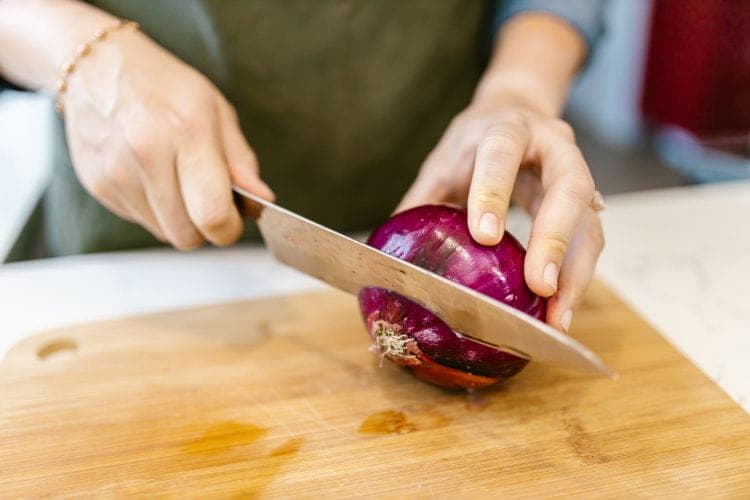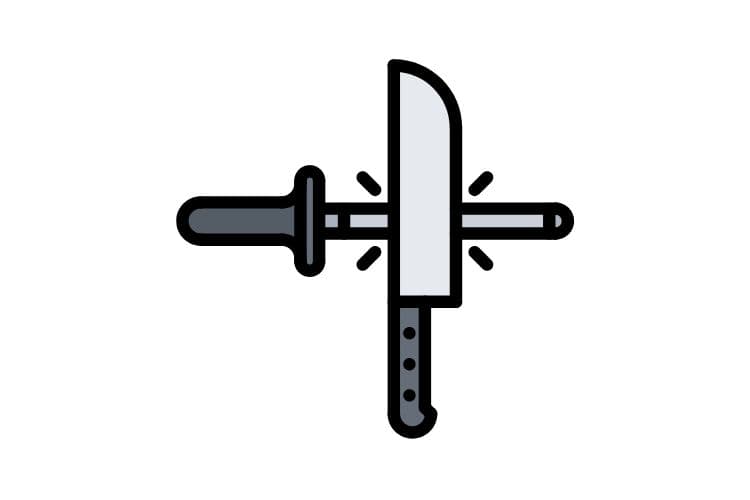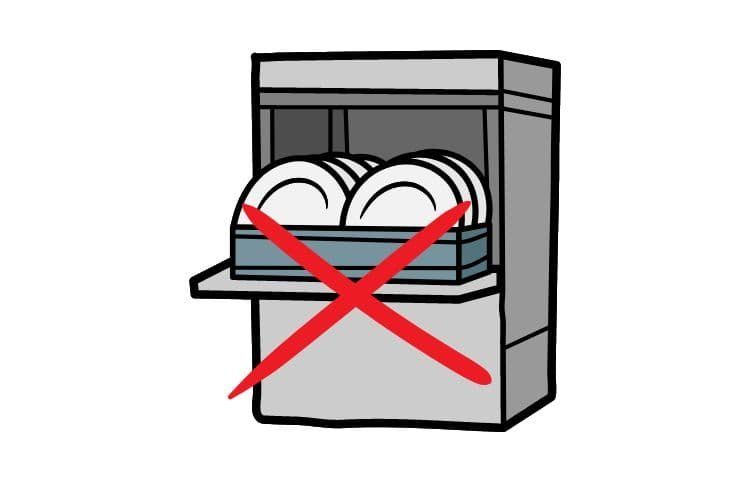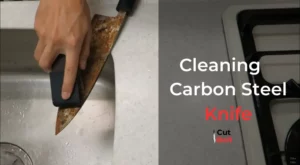Most people instinctively know when they are about to do something that could damage their knife. So if you think this is a bad idea, don’t do it. Here is the guide on how to take care of a knife.
With the previous paragraph we could summarize this entire topic. For those of you who are looking for more detailed information on how to take care of your tools, we are going to develop it a little more.
We are going to break down one by one all those things that influence the good care and conservation of our knives. At the end of the article you can find a summary list where you can review everything at a glance.
Usefull post you can read:
- How to Clean Carbon Steel Knife: A Complete Guide
- How Do You Sharpen A Ceramic Knife At Home? 5 Easy Methods
- When Must a Knife Be Cleaned and Sanitized?
- How to force a patina on a knife (Complete guide)
- How to mirror polish a knife by hand
- Learn to use the knife well
- Sharpen the knife frequently
- Don’t let the knife get too dull
- Use a knife friendly cutting board
- Do not use the edge to drag ingredients
- Use the right tool for each job
- Do not cut things that you should not cut
- Clean knives right after use
- Don’t wash knives in the dishwasher
- Keep knives separate from each other
Learn to use the knife well
The first basic rule. Hold the knife securely and learn how to use it effectively.
There are people who use knives with suspicion, especially if they are very sharp. You don’t have to be afraid of the tool, you have to use it carefully and judiciously.
If this is your case, slowly practice the cutting technique or ask someone who is proficient at cutting to teach it to you.
An insecurely handled knife is a danger to both the tool and the user. This will prevent cuts or slips and there will be less chance of the knife falling to the ground or hitting other objects.

Sharpen the knife frequently
A knife is a tool designed for cutting. If it is not well sharpened two things happen. The first one is not fulfilling its function well. That costs us an extra effort to obtain a good cut.
The second is that a dull knife is dangerous. If the knife does not cut easily just by supporting it, you will have to increase the force to apply more pressure. That increases the risk of the knife slipping and being forcefully deflected. A knife that cuts smoothly does not deviate from its path.
Of course, with a very sharp knife, you have to have a good cutting technique. Because it cuts whatever we put in front of the knife. A food item or a finger. To avoid injury: learn to use the knife well.
In case of a cut, a sharp knife opens clean wounds that heal easily. A blunt knife causes wounds with irregular edges with tissue crushing.
Don’t let the knife get too dull
It is the logical continuation of the previous point.
If you don’t let the knife dull too much before re-sharpening it, you will achieve two things.
First, sharpening will be easier each time. Sharpening a very dull knife takes a lot of time and effort.
Second, the amount of metal that we remove from the blade in each sharpening is less. The more damaged an edge is, the faster it continues to deteriorate. And the more it has deteriorated, the more metal we will have to remove to leave it as it was at the beginning. Lengthening the gap between sharpenings eventually means we have to remove more metal from the blade than sharpening often. As a result, the service life of the knife will be less.
The explanation for this is simple. A dull knife requires more force to cut with it. Therefore, more cutting edge metal is lost through wear, crushing, and gouging. By keeping the knife sharp we turn this situation around.

Use a knife friendly cutting board
Do not even think about cutting on marble, metal, glass, ceramics or similar. All of these materials are too hard for how delicate a knife edge is. No knife is prepared to withstand that treatment and continue to function well.
Instead, cut on a cutting board. They are designed for that purpose. You can use wooden, plastic, or rubber boards. To learn more about cutting boards visit this article (cutting boards).
That the knife is made of hard steel does not mean that it is resistant. As far as metal is concerned, “hard” means “brittle”. To take it too far, he thinks the knife blade is made of glass. Steel can take more abuse, but roughly that’s the idea.
Do not use the edge to drag ingredients
This is undoubtedly the most common form of abuse when using a knife.
The same thing happens on every cooking show I’ve seen. When finishing finely chopping an ingredient, the chef drags it with the knife to one end of the board. And for that, he uses the part of the edge, which rubs along the entire surface.
Without going into too much detail, the edge is a precision tool. The rest of the knife is specifically built to support the edge. And that precision tool, if well maintained, is no more than a few microns thick.
Dragging such a delicate part on a surface causes enormous tension. In doing so, the steel of the cutting edge bends and splits.
Imagine that you apply force on a nail. You can nail it through wood or even cement with no problem. It supports very well the vertical compression force. However, it bends easily if the force is applied from the sides. The same thing happens to the edge of a knife.
If you need to drag what you just cut on the table there is a very simple trick. Flip the knife over and drag it with the spine.

Use the right tool for each job
This is a matter of common sense, but it also helps extend the useful life of knives.
A knife is a tool designed for a specific purpose. By the time you have read several articles at Cut Bolt you will see that it is one of the things that I repeat the most. And I do it because it’s one of the most important things to be clear about with a knife.
A knife is a knife. It is designed to cut. And depending on the type of knife, it will be designed to cut one thing or another. Or to cut one way or another. That is what it is.
What is NOT a knife is anything else you can think of that is out of that norm. A knife is not a screwdriver, not a crowbar, not an axe, not a hammer.
Any use other than that for which it was designed is to abuse the knife. And the blade of a kitchen knife is not designed to withstand any type of abuse.
If you need to use a knife like a screwdriver, use a screwdriver instead. And if you need to use a knife like a hammer, use a hammer.
If you have to do a task when cooking that you could use a hammer for, have one in your kitchen. They are tools designed for a specific task, just like knives. There is nothing wrong with it.

This is one of the most important tips. If you do not respect it, it is likely that you will not only end up damaging the knife, but also end up injuring yourself.
Following the line of the above, there are knives designed for very diverse uses. It is a practical matter to use a suitable knife for each task. For example, you wouldn’t cut a beef bone with a chef’s knife or a santoku. Just as you wouldn’t peel a potato with a kitchen cleaver.
Each tool has its use, and it should be respected. If you wouldn’t put a Ferrari down a stone path in the mountains, don’t mistreat your knives in the kitchen.
Do not cut things that you should not cut
This advice is a logical consequence of the previous one. If the edge is a delicate element, we should not force it by cutting things that it should not cut.
Knives are designed to make the finest cut possible, and nothing more. If you want to open some oysters or if you want to chop frozen food you should use other tools.
As a rule of thumb: if you wouldn’t bite into it with your teeth, don’t cut it with a kitchen knife.
Clean knives right after use
It is important to keep knives clean and dry.
Even if they are made of stainless steel, clean them as soon as you finish using them. Do not let dirt and moisture remain on the surface of the sheet for a long time.
Although we say that the steel is stainless, it really is not. It is only rust resistant, and some are more so than others. But it is not a guarantee that rust will not appear on the surface if we take care of it poorly.
Don’t leave them lying in the sink, surrounded by hard things that they can bump into, either. Not only is it dangerous for anyone who puts their hand inside, but the edge will quickly deteriorate.

If you can’t scrub it when you finish using it, at least rinse the blade under the tap and then dry it with a cloth. Set it aside in an empty spot on the counter until you have time to scrub it.
For more detailed tips on how to scrub a knife check out this article (how to scrub a knife).
Don’t wash knives in the dishwasher
Japanese chefs believe that part of our souls pass into our knives as we use them. And as Chef Morimoto says, you wouldn’t put your soul in the dishwasher.
Jokes aside, we shouldn’t be washing knives in the dishwasher for quite a few reasons. The main ones are:
- Presence of aggressive chemicals in wood and metal.
- Atmosphere with a large amount of heat and humidity can expand and crack the wood.
- Blades and moving parts with a risk of hitting.
- Presence of other cutlery and hard kitchen utensils, with risk of hitting.
- Possibility that the knife cuts by pressure through the waterproof coating of the shelves.
All of them create a hostile environment for our knives, including the blades, the cutting edges and the handles.

Contrary to popular belief, the temperature of the dishwasher does not pose a danger to the steel of the blade. Unless your dishwasher heats the water above 200°, you should not worry about that particular aspect.
To wash the knives, only a soft cloth, warm water and detergent should be used. Again, for more detailed tips on how to scrub a knife check out this article (how to scrub a knife).
Keep knives separate from each other
As we saw in this article (the best ways to store your knives), the way we store knives is important.
The golden rule when storing or transporting them is that we must prevent the edge from hitting something hard.
That is why we cannot store all the knives together in a drawer or put them in the sink.
What we must do is store them in supports that keep them separated from each other. For this, the best options are countertop or wall magnetic mounts. You can read more about it in this article (types of knife holders).
For when you transport them you can do it either in their boxes or inside a roll or knife blanket. In the second case, the blades should be protected with a sheath for edges or with a saya. If you don’t have any you can improvise them with cardboard or newspaper.
How to care for carbon steel knives
Caring for carbon steel deserves a separate topic all to itself.
Apart from what we have told so far, the owners of a carbon steel knife need to take some extra precautions.
You can find them in this article (how to take care of a carbon steel knife).
In summary – How to take care of a knife
Here’s a complete and summarized list of everything we’ve talked about so far and some more details. To consult in case of doubts or to print it and give it to a friend or family member who has just bought his first knife. May it be useful to you:
- Sharpen your knife frequently. It is the only way to make it work at all times as it should.
- Do not use the knife if it is broken or damaged.
- Please keep the knife out of the reach of children. Always keep it in a safe place. If you allow them to use it, always do so under adult supervision.
- Always cut on a cutting board. Do not cut on hard surfaces such as stone or metal.
- Use the knife for what it is designed for. Don’t use it for anything other than cooking.
- Do not pry or twist the blade. It can chip or break.
- Do not try to cut, separate, or hit bones or frozen food with the knife. The blade can be nicked or broken.
- Food must be completely thawed before cutting.
- To cut particularly hard items such as fish bones or scales, use a specific knife. A machete or a deba are good options.
- Do not use the knife to open cans or bottles.
- Do not put the knife in the dishwasher.
- Clean and dry the knife blade after use.
- Carbon steel blades rust quickly. Dry the sheet as you use it.
- Do not leave the knife submerged in water or in the sink.
- Dry the leaf with paper or a cotton cloth. Do not attempt to dry the sheet in an oven or microwave.
- Wash the knife by hand using a soft cloth and detergent. Rinse it well and let it dry well.
- Do not rub the knife with rough scouring pads, abrasive sponges or metal brushes. They will leave scratches on the surface of the sheet.
- Be careful how you hold the sheet as you wash it.
- Avoid storing the knife in a humid place.
- If rust stains appear, remove them by rubbing with an abrasive pad or sandpaper.
- For knives with traditional Japanese handles: Avoid submerging the wood under water. Don’t hit the handle hard.
- Do not bring the blade near a flame. It can burn the metal and damage the heat treatment.
- Do not store knives in a place where the edge is not protected. Use holders that keep the knives separate or protect them with blade guards or sheaths.
- Store your knives well when transporting them. Don’t wear them loose. Take them in a case that keeps them fastened and protects the edges with covers or skirts.



